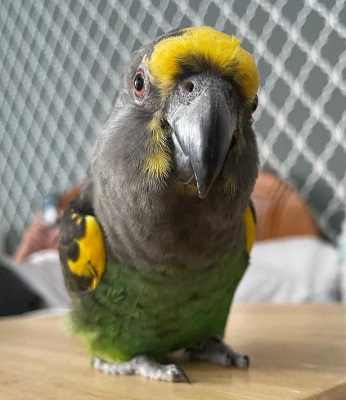
Time is marching on as March draws to a close. And so our Animal of the Month, the Meyer’s parrot, is flying out of the spotlight today to make way for a new featured creature. As Meyer’s parrots are social birds, we also hope you were social with us on Twitter as we tweeted about them all month long @ExoticPetVets. But if you missed any of our tweets throughout the month, you can find a summary of them right here. Did you know?:
- Meyer’s parrots (Poicephalus meyeri) have a huge natural range and are endemic to mostly inland parts of southern, eastern and central sub-Saharan Africa.
- In the wild, Meyer’s parrots can be found in either all or parts of more than a dozen countries, including Chad, Sudan, South Sudan, Ethiopia, Uganda, Tanzania, Angola, Namibia, Zambia, Zimbabwe and South Africa.
- The population of Meyer’s parrots in the wild is considered to be stable overall, according to the IUCN Red List.
- But the numbers of wild Meyer’s parrots are falling sharply in Zimbabwe and South Africa because of habitat destruction, trapping for the pet trade and persecution over the perception that they’re agricultural pests.
- In the wild, Meyer’s parrots typically live in open woodland and savanna habitats.
- Wild Meyer’s parrots also live in gallery forests, which are forested corridors that run along wetlands or rivers. Gallery forests are also known as riparian, riverine or fringe forests.
- Meyer’s parrots are considered to be “resident” birds as they are not migratory. But they will wander locally if they need to search for food.
- The Meyer’s parrot is a stocky medium-sized parrot with a short tail. Adults grow to an average length of between 8 – 9 inches (21 – 23 cms).
- Meyer’s parrots are also known as brown parrots and there is good reason for that. Most of the plumage on their heads and bodies is a dull dark brown.
- But Meyer’s parrots also sport striking patches of brilliant colour. They have green or turquoise bellies and blue rumps.
- Meyer’s parrots have bright yellow feathers on the carpal joint or “wrist” part of their wings, as well as the covert or under wing feathers. There are also yellow feathers on their legs and in a band along their foreheads.
- While Meyer’s parrots are considered to be sexually dimorphic because of slight differences in colouration between females and males, it is often challenging to determine the bird’s gender without doing a DNA test.
- Did you know that the breeding season for Meyer’s parrots in the wild varies depending on where they live?
- For example, Meyer’s parrots who live in Zimbabwe typically breed between March and August; while those who live further north in Ethiopia will usually breed between April and October.
- Meyer’s parrots will nest in tree cavities, often in old woodpecker cavities between 3 and 10 metres off the ground. Birds who use abandoned or natural tree cavities as nesting sites are known as secondary cavity nesters.
- There are usually 3-4 eggs in a clutch and they will hatch after about 25 days of incubation. Both the female and male Meyer’s parrot will feed their chicks.
- Meyer’s parrot chicks will leave the nest about 8–9 weeks of age, but they may have lingering dependence on their parents for another few weeks after that. They will reach sexual maturity at around 3-4 years of age.
- Meyer’s parrots are mostly herbivorous. In the wild, they will eat berries and other fruits, nuts, seeds and flowers. But they will also indulge themselves on grain crops and insects.
- Meyer’s parrots are diurnal, meaning they are active during the day. They are social birds and can be seen gathering at food sources in pairs or small flocks of up to 50 birds. They will roost at night in tree cavities.
- Because they are not very big, Meyer’s parrots are prey animals for larger birds of prey and snakes.
- Meyer’s parrots are known for being affectionate, playful, easy-going and gentle.
- While they may be able to say a few words, Meyer’s parrots are not well known for their ability to mimic human speech. But they can whistle and may imitate sounds they hear in their environment.
- Overall, Meyer’s parrots are generally quiet and don’t have a tendency to squawk or scream. So they can be good companions for people who are sensitive to noise and/or live in apartments or condos.
- Meyer’s parrots have a long lifespan and, on average, can live between 20-30 years with proper care.

